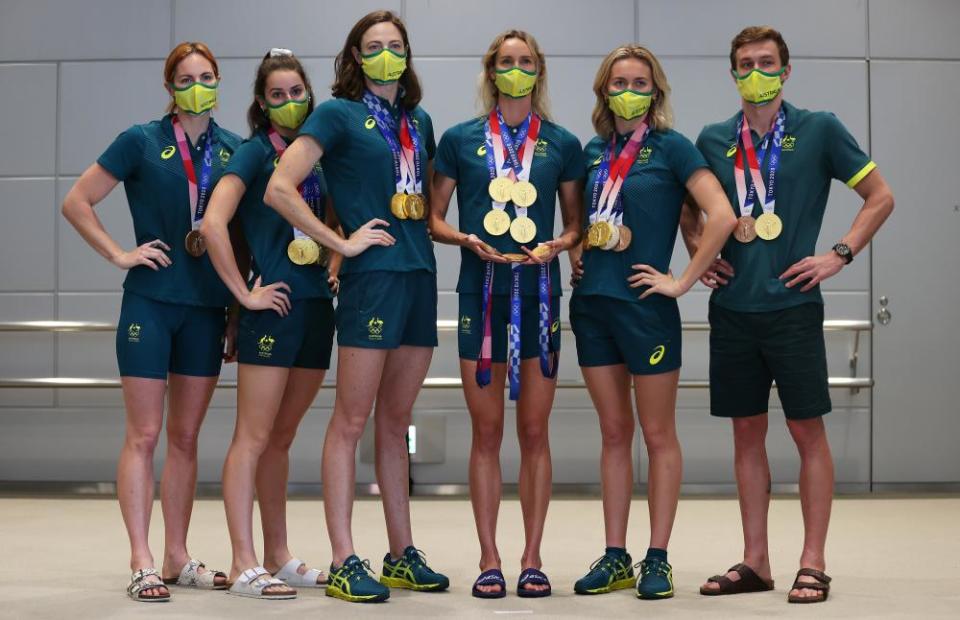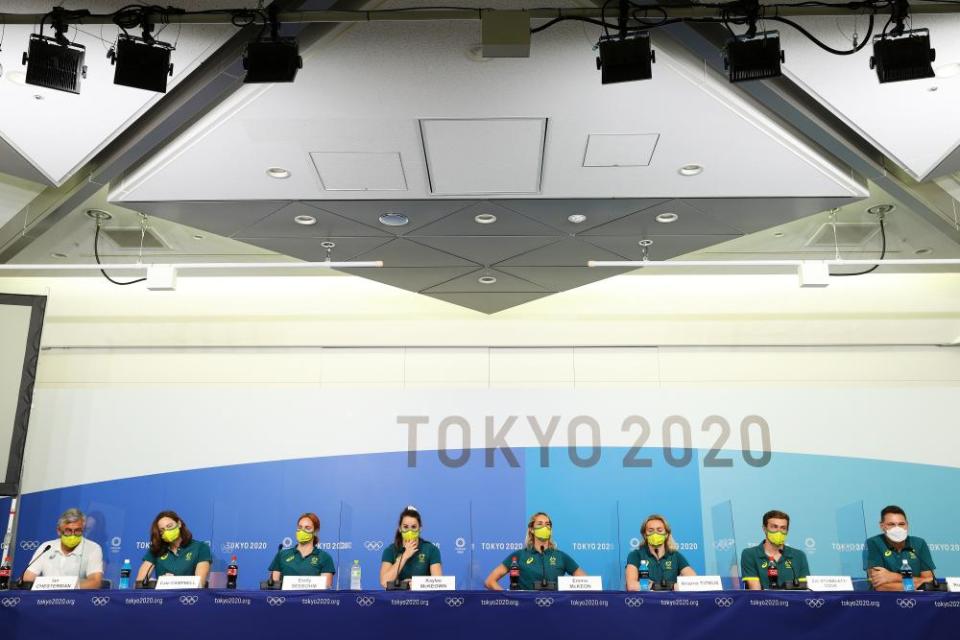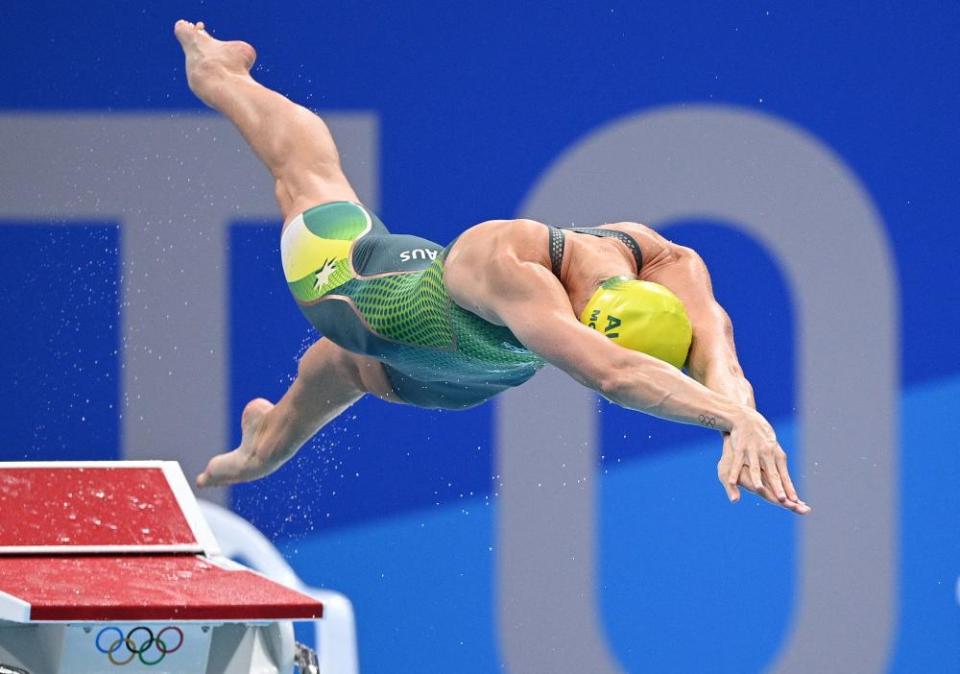Australia’s swimmers target Paris after record-breaking Tokyo medal haul

In February, Australia’s swim team gathered on the Gold Coast for a pre-Olympic camp. Midway through the week, Australia’s best swimmers arrived at the pool expecting a typical training session. But head coach Rohan Taylor was waiting with a surprise.
Related: Swimming Australia boss Alex Baumann quits after three months in the job
“Rohan had a really good idea,” explained Michael Bohl, coach of Australia’s Tokyo 2020 swim star Emma McKeon. “He just said: ‘Guys, you don’t know what’s going to happen, here’s what’s going to happen. We divide you into two teams – green and gold. These are the events you’re doing.’” Taylor had sprung an unexpected series of races on his team.
The swimmers changed into their swimsuits and returned to the pool deck to race. “They got out of their comfort zone and raced hard to try and win,” said Bohl. Six months later, standing inside the Tokyo Aquatics Centre after the final day of the Olympic swim meet, Bohl recalled that day on the Gold Coast.
“You watch that last relay for the women there and you just saw people fighting for that gold medal,” said Bohl, moments after witnessing the McKeon-led 4x100m women’s medley relay team beat the United States to gold by less than two-tenths of a second. “I think that day [in February], in my mind, was the catalyst for what we saw today and especially in those relays all the way through.”
At Tokyo 2020, Australia’s Dolphins – the swim team’s nickname – had their most successful Olympics in history. The nation collected nine gold, three silver and eight bronze medals in the pool, plus a first-ever medal – bronze – in the open water marathon swimming. The haul betters Australia’s eight gold medals at the 1956 Olympics in Melbourne (although there were less events on the swim program at the time). Australia also won a medal in six of the seven relays, which had been an area of renewed focus for the team.
“One of the philosophies that I was bringing to the team was we were going to enter into an environment that was just going to throw up things – no certainty,” said Taylor of his surprise February mini-competition. “What I wanted to do was to … basically just throw them off. So not only did we put a relay competition on, but we did up the pool – with fireworks and all kinds of stuff. I wanted to see how they responded. I wanted them to understand that they are capable of responding. The hope was to bring that to fruition so that when they got here they could draw on that experience.”
Related: Australia’s swimmers lead pack closing gap on US in Tokyo
Tokyo 2020 marked an emphatic return to form for the Australian swim team. Following the disappointment of just one gold medal at London 2012, there was some improvement in Rio in 2016 – albeit the haul of three gold medals was still considered to be short of the team’s potential. Despite the turbulence of the past 18 months and the lack of international competition, Australia’s swimmers – individually and in relay teams, Olympic debutants and the more experienced stars – were dominant in Tokyo.
Swimming can be a game of centimetres and milliseconds, which means definitively explaining Australia’s medal success is an impossible task. In the velodrome last week, Great Britain’s Jason Kenny said: “We’ve always been on the right side of the few 10ths it takes to win. This time we were on the wrong side.” For the Australians in the pool, the opposite was true.
But some factors are readily identifiable. In Tokyo it was obvious that the Dolphins are a tight-knit team. “The team is super close,” said Mitch Larkin, a member of the leadership team. “We come away from a meet like this and really miss each other’s company. We’re so like-minded. And you can see it not only in the way we’re swimming but the way the team interacts with one another.”
Dutch coach Jacco Verhaeren, who headed the Dolphins between 2014 and 2020, had set in place structures and strategies that have put the team on the path to success. “He has really set a tone for us and we’ve just built that and created that momentum,” added Taylor.

Covid has assisted some of that team cohesion. The pandemic spurred coaches, staff and senior swimmers to spend more time than usual on team bonding, which paid dividends in Tokyo. The Covid restrictions imposed on the team at the Games also meant more togetherness – quite literally, as they were often required to travel together from the athlete’s village to the Aquatics Centre. In an ordinary Games, athletes and their coaches have more autonomy. “We’ve got this young group of athletes who are just resilient and determined,” said Taylor. “They just keep each other up.”
More experienced members of the team have also learnt hard lessons from prior disappointment. Despite becoming Australia’s most successful Olympian of all time in Tokyo, McKeon had never previously won an individual Olympic race (she won relay gold in Rio but finished third in the 200m freestyle). “What’s that saying? The definition of insanity is doing same thing over and over again and expecting a different outcome,” said her coach, Bohl. “I think she’s learnt from those bad swims that she’s had – she’s able to turn it around. Having the rollercoaster ride of emotions in Rio really helped her hold it together here.”
The team’s work on relays – with specialist relay camps, a focus on technique and sports science-led research into optimum team composition – has also fostered togetherness. As much was evident on the final day of the swim meet when head coach Taylor was asked to pick his favourite moment of Tokyo 2020. Despite his team winning nine gold medals, the coach picked Australia’s bronze medal in the mixed medley relay – the first-time a mixed-gender event had featured on the Olympic program.
“Honestly – it’s like who’s my favourite daughters out of my three daughters,” Taylor said. “The mixed relay medal was a really special one. We went around – we had so many scenarios – we just really worked on that. That one for me, that was one of the ones I felt we pinched because we got it right … That was the moment I was jumping up and down the most.”

After their stints in hotel quarantine at Howard Springs in the Northern Territory, most of Australia’s swimmers will take a well-deserved break. They are currently midway through their two weeks in isolation. “I’m going to take a break and try and reflect on what I’ve done here,” said Ariarne Titmus in her final press conference before flying home last week, sitting next to rival Katie Ledecky of the United States. “And like Katie, I want to let it sit for a bit, and then reassess.
“I think that’s the biggest thing – I want to have longevity in my swimming career. I think if I quickly move on to the next thing that might catch up with me. So I really need to sit and chill for a bit – soak it in while I can.”
The Dolphins will then regroup for a big calendar ahead. Australia’s swimmers will return to Japan in early 2022 for the Fina World Aquatics Championships in Fukuoka, before heading to Birmingham mid-next year for the Commonwealth Games. From there, the 2024 Olympics in Paris will be just two years away.
It will not all be smooth sailing in the years ahead. On Monday, Swimming Australia announced that new chief executive Alex Baumann had resigned due to health concerns after just a few months in the role. The peak body has also recently commissioned an independent panel to review culture concerns, following allegations of harassment and mistreatment by Rio medallist Maddie Groves.
Related: Magnificent McKeon headlines historic day for Australia in Tokyo | Kieran Pender
Australia’s rivals in the pool will no doubt come back stronger. The United States underwhelmed in their first Games following the retirement of Michael Phelps while Great Britain had its best Olympics in the pool. Canada’s Summer McIntosh, at age 14 finished fourth in the women’s 400m freestyle in Tokyo, will be a threat to Titmus and Ledecky in Paris.
To ensure future podium potential, Swimming Australia is investing in pathway programs and partnering with a privately-owned company to develop a series of domestic competitions, to be known as the Australian Swimming League. “We need to develop more competition opportunities for our athletes so that they can become more resilient,” said Taylor. “How we do that with Covid is quite challenging but domestically we need to look at how we can do that – how we can make our competitions more meaningful.” The ASL will certainly help.
But these caveats aside, the future is bright for Australia’s Olympic swim team. Two-time individual gold medallists Titmus and Kaylee McKeown are just 20. The latter is expected to add individual medley to her backstroke program in the years ahead. Breakout breaststroke star Zac Stubblety-Cook, the only Australian man to win a gold medal in the pool, is 22. Elijah Winnington – considered a pre-Games favourite in the men’s 200m and 400m freestyle – will bounce back after disappointment in Tokyo after failing to win a medal in either event. All have time on their side. Even team veteran Emma McKeon – 27 – may well return for another Olympics. “I still think she has a bit to go,” her coach Bohl said.
Success begets success. “Of course when you get on a roll, momentum gets going, people start believing and then we’re sharing in that because we’re connected and we’re making sure we talk to each other,” said Taylor. After a golden Tokyo Olympics, Australia’s swimmers are already looking forward to Paris in three years’ time.

